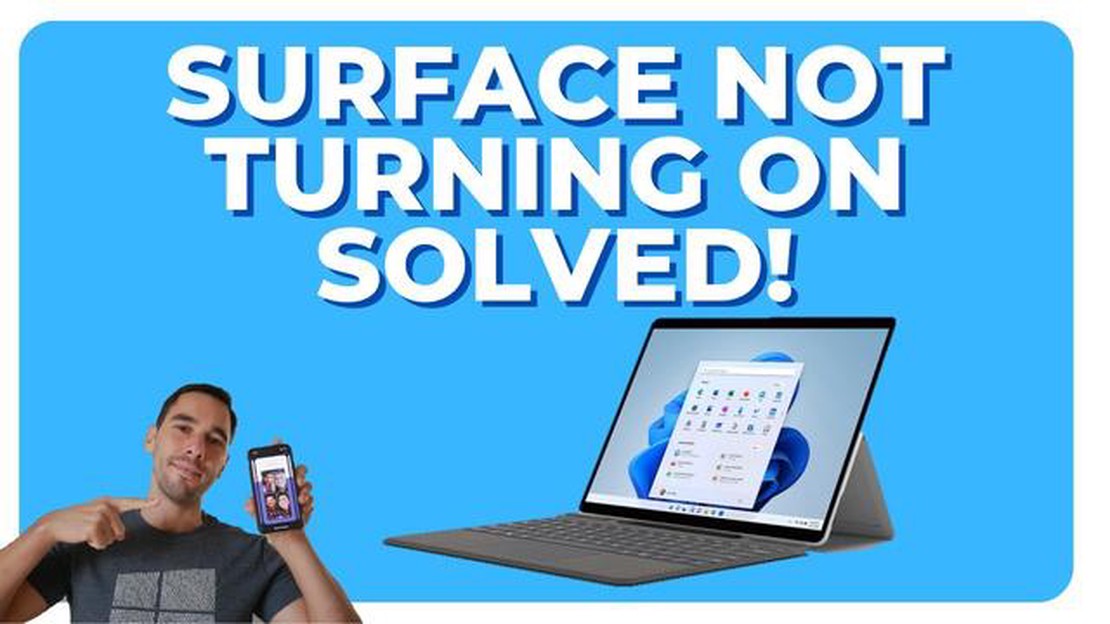How to Troubleshoot Star Wars Jedi Survivor Crashing Issue on PC - Easy Solutions
How to Fix Star Wars Jedi Survivor Crashing Issue on PC If you’re a Star Wars fan and you’ve been experiencing crashes while playing Star Wars Jedi …
Read Article
Is your Microsoft Surface tablet not turning on? Don’t worry, you’re not alone. Many Surface users have encountered this frustrating issue at some point. Whether your device simply won’t power on or it turns on but gets stuck on the startup screen, there are several potential solutions you can try before giving up and contacting support.
First, check the basics. Make sure your Surface is properly charged by connecting it to a power source. If it still doesn’t respond, try force restarting it by holding down the power button for at least 30 seconds, then release and press the power button again. If this doesn’t work, try connecting your Surface to an external display to see if it’s a screen issue.
If your Surface still won’t turn on, it might be a hardware problem. In this case, it’s best to contact Microsoft support or visit an authorized service center to get professional assistance. They can diagnose the specific issue and suggest the best course of action, whether it’s repairing or replacing the device.
In conclusion, don’t panic if your Microsoft Surface won’t turn on. Try troubleshooting steps like charging, force restarting, and connecting to an external display. If these don’t work, seek professional help to resolve the issue. Remember, persistence and patience are key when dealing with technology problems!
If your Microsoft Surface won’t turn on, it can be a frustrating problem to deal with. However, there are several troubleshooting steps you can take to try and resolve the issue. Follow these steps below:
If none of these steps fix the issue and your Microsoft Surface still won’t turn on, it may be a hardware problem. In that case, it’s recommended to contact Microsoft Support or take your device to a certified repair center for further assistance.
Read Also: How To Fix It If Samsung Galaxy S21 Won't Charge: Troubleshooting Guide
If your Microsoft Surface is not turning on, here are some troubleshooting steps you can try:
Remember to backup your important data before attempting any troubleshooting steps that may result in a system reset or data loss.
If none of these troubleshooting steps resolve the issue, it is recommended to contact Microsoft support or bring the device to a professional technician for further assistance.
There can be several reasons why your Microsoft Surface is not turning on. It could be due to a drained battery, a faulty power adapter, a hardware issue, or a software problem.
Read Also: Why Call of Duty Mobile does not work on Android emulators? Find the solution!
If your Microsoft Surface doesn’t respond when you press the power button, you can try a few troubleshooting steps. First, make sure the battery is charged by connecting the power adapter. If that doesn’t work, press and hold the power button for 30 seconds to force a restart. You can also try disconnecting any peripherals or accessories connected to your Surface and then trying again.
If your Microsoft Surface only turns on when it’s connected to the power adapter, it could indicate a problem with the battery. The battery may be drained or not functioning properly. Try charging the battery for a few hours and then check if it turns on without the power adapter. If the issue persists, you may need to contact Microsoft support for further assistance.
Yes, a software issue can cause your Microsoft Surface not to turn on. If the operating system or firmware becomes corrupted, it can prevent the Surface from booting up properly. In such cases, you can try performing a system reset by holding down the volume up button and the power button simultaneously for 15 seconds. This will force the Surface to restart and may resolve the issue.
Yes, you can perform a hardware diagnostic test on your Microsoft Surface to check for any hardware issues. To do this, press and hold the volume up button and the power button simultaneously for 10 seconds. This will bring up the UEFI menu. From there, you can navigate to the diagnostic options and run tests on the hardware components of your Surface. If any issues are detected, you may need to contact Microsoft support for further assistance.
How to Fix Star Wars Jedi Survivor Crashing Issue on PC If you’re a Star Wars fan and you’ve been experiencing crashes while playing Star Wars Jedi …
Read ArticleHow To Fix Nvidia High Definition Audio No Sound On Windows 10 If you are experiencing audio issues with your Nvidia High Definition Audio on Windows …
Read ArticleHow To Fix Another Installation Is In Progress Error In Windows 10 Windows 10 is a widely used operating system known for its user-friendly interface …
Read ArticleA beginner’s guide to rusting. Rust is a common problem faced by many people. It can appear on various surfaces such as metal, iron, steel and other …
Read ArticleRyse: son of rome 2: still possible? Son of Rome, released in 2013, was one of the first games to introduce the possibilities of next-generation …
Read ArticleHow to watch Harry Potter On Netflix anywhere Harry Potter is one of the most beloved and iconic film franchises of all time. Fans around the world …
Read Article